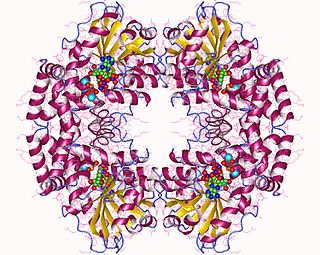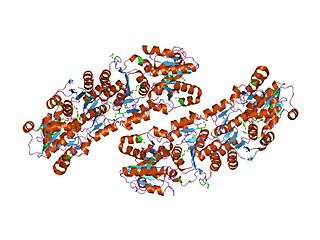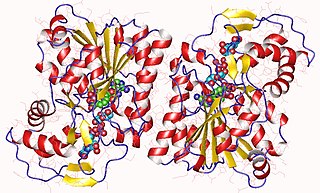| UDP-N-acetylmuramate dehydrogenase | |||||||||
|---|---|---|---|---|---|---|---|---|---|
 UDP-N-acetylenolpyruvoylglucosamine reductase homodimer, Mycobacterium tuberculosis | |||||||||
| Identifiers | |||||||||
| EC no. | 1.3.1.98 | ||||||||
| CAS no. | 39307-28-3 | ||||||||
| Databases | |||||||||
| IntEnz | IntEnz view | ||||||||
| BRENDA | BRENDA entry | ||||||||
| ExPASy | NiceZyme view | ||||||||
| KEGG | KEGG entry | ||||||||
| MetaCyc | metabolic pathway | ||||||||
| PRIAM | profile | ||||||||
| PDB structures | RCSB PDB PDBe PDBsum | ||||||||
| Gene Ontology | AmiGO / QuickGO | ||||||||
| |||||||||
In enzymology, an UDP-N-acetylmuramate dehydrogenase (EC 1.3.1.98) is an enzyme that catalyzes the chemical reaction
- UDP-N-acetyl-alpha-D-muramate + NADP+ UDP-N-acetyl-3-O-(1-carboxyvinyl)-alpha-D-glucosamine + NADPH + H+
Thus, the two substrates of this enzyme are UDP-N-acetyl-alpha-D-muramate and NADP+, whereas its 3 products are UDP-N-acetyl-3-O-(1-carboxyvinyl)-alpha-D-glucosamine, NADPH, and H+.
This enzyme belongs to the family of oxidoreductases, specifically those acting on the CH-CH group of donor with NAD+ or NADP+ as acceptor. The systematic name of this enzyme class is UDP-N-acetyl-alpha-D-muramate:NADP+ oxidoreductase. Other names in common use include MurB reductase, UDP-N-acetylenolpyruvoylglucosamine reductase, UDP-N-acetylglucosamine-enoylpyruvate reductase, UDP-GlcNAc-enoylpyruvate reductase, uridine diphosphoacetylpyruvoylglucosamine reductase, uridine diphospho-N-acetylglucosamine-enolpyruvate reductase, uridine-5'-diphospho-N-acetyl-2-amino-2-deoxy-3-O-lactylglucose:NADP-oxidoreductase. This enzyme participates in aminosugars metabolism. It employs one cofactor, FAD.











